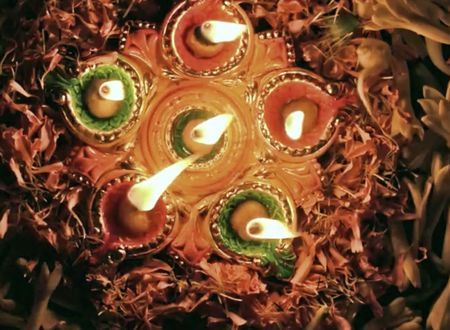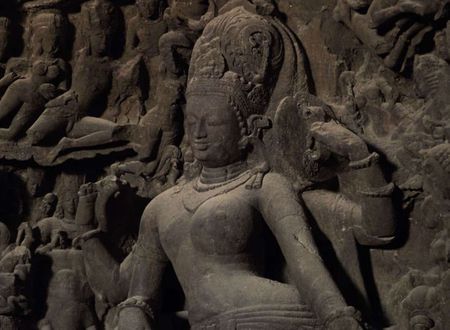You may like to read Part 7 here.
Verse 8:
sa paryagāt śukraṃ akāyaṃ avraṇaṃ asnāviraṃ śuddhaṃ apāpaviddham
kaviḥ manīṣī paribhūḥ svayambhūḥ yāthātathyatorthān vyadathāt śāśvatībhyaḥ samābhyaḥ (8)
Literal Meaning:
He, who has gone abroad pervaded all, resplendent, bodiless, scatheless, having no muscles, pure, untouched by sin; far-seeing, omniscient, transcendent, self-sprung, (he) duly allotted to the various eternal creators their respective functions.
My Personal Understanding :
The first word to pay attention to in this verse is ‘He’. He indicates Isha, the ruler of this universe. The same Isha, the masculine aspect is said to become ‘matarishva’, the feminine aspect, both are said to be inhabiting the universe.
sa paryagāt
Now, the text says he, who has gone abroad. The texts suggest that this Supreme who seems to have personality and is inhabiting the universe has gone abroad. This means there is an impersonal and unmanifested aspect of the Divine that can not be conceived and be known. That is unknowable, unknown, and is usually denoted as ‘Tat’, a neuter gender. Although ‘Tat’ is unknown, this verse attempts to describe ‘Tat’. It is very important to understand that although there is an attempt to describe the impersonal aspect of the Divine, this aspect is without gunas, and can not be spoken of.
Śukraṃ
Resplendent – Bright – Although he is inconceivable, he is conceived here as bright to denote his unknown glorious aspect.
Akāyaṃ
Bodiless – Unmanifested – The entire universe is the body of the Isha, the manifested Lord, he manifests as Purusha, in a masculine aspect, and then as Mula-Prakriti in a feminine aspect. Prakriti and Purusha are one and the same reflecting masculine and feminine aspects. However, the ‘Tat’, the one who has gone abroad neither can be conceived as Self nor as Universe.
Avraṇaṃ
Scatheless – As long as Purusha is within the Prakriti, the consciousness is interrelated with the emotions, one can learn mindfully not to respond to the emotions, but to emotions, one will inevitably experience. The Law of nature still remains the same. The Purusha, once attaining self-realization does not get affected by injury or harm, yet he appears to be injured or harmed. However, the Purusha exists beyond the time, space, and cause also and there he is scatheless. With no physical, mental body, or casual body, No harm or injury can touch the Purusha there as there is no existence there except him. He alone exists.
Asnāviraṃ
Without muscles – The Vital energy, Prana is considered a dynamic force of the Lord taking his power everywhere. The Lord in this aspect does not pour itself into the energy of dynamic life, hence is known as without muscles.
Śuddhaṃ
Pure- Since there is no play of gunas there, neither good nor bad exists, hence Supreme is Pure.
apāpaviddham
Without Sin – What we call, evil or sin, is the result of inharmonious action and reaction of various gunas and their play upon each other. Since there is neither action nor reaction, it is referred to as without sin.
kaviḥ manīṣī paribhūḥ
Witness principle- ‘Tat’ projects Himself into the play and the movement, becoming there in His self-existence all that the Seer( Purusha) in Him visualizes and the Thinker(Mahat Tattva) in Him conceives.
Svayambhūḥ
Self-sprung – Everything that is manifested, the Purusha, the self-conscious principle, or the Prakriti, the universe, and its various dynamic forces have sprung out of ‘Tat’. It is, manifested subject, the self-conscious principle, and the manifested object, the material for the universe. Out of IT, came forth the seer and the seen, the twinfold aspect of the universe. But IT, is self-sprung, unknown, inconceivable, unmanifested.
One more thing, to understand here is that whatever has manifested out of IT, is complete in itself. He alone has manifested. Both his aspects are complete and inclusive.
yāthātathyatorthān vyadathāt śāśvatībhyaḥ samābhyaḥ
The world is not running on its own. The one seer who is unmanifested, first manifested himself into the play and movement and then duly allotted to the various eternal creators their respective functions. In Samhita and olden texts, they are revered as 33 divine beings(Devas) that are ordained the cosmic functions. 11 Rudras, 12 Adityas, 8 Vasus, and 2 Asvinkumaras. It is very important to understand that the highest principle, One being itself is adored here. The idea is to invoke the oneness of the divine being in apparent separateness by glorifying his manifested aspects.
You may also like to read here about 33 kotis here.
To be Continued…
🌼🌼🌼All Glories to Swamiji Alone🌼🌼🌼









Comments & Discussion
2 COMMENTS
Please login to read members' comments and participate in the discussion.